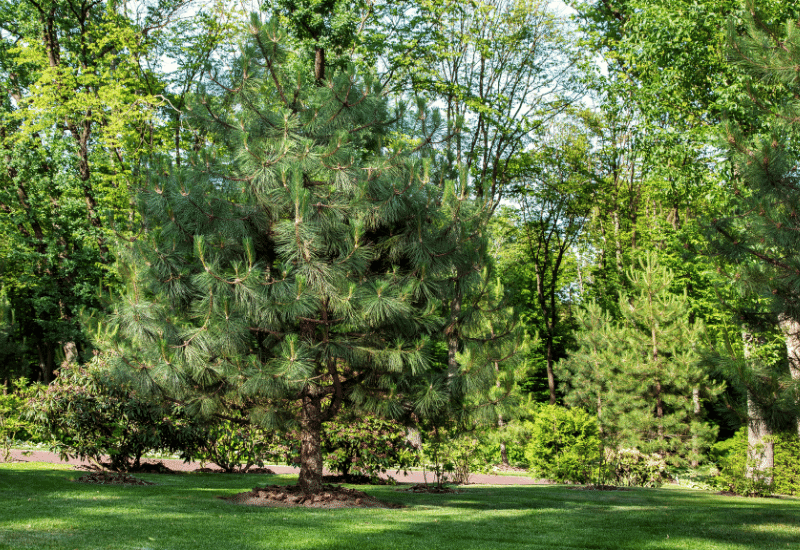
Pine trees, belonging to the genus Pinus, comprise around 126 distinct species of needle-leaved evergreen coniferous trees and shrub within the Pinaceae family, appearances vary greatly from species to species. While many envision pines as upright, cone-bearing trees with needles, there are exceptions, like the umbrella-canopied Italian pine or the twisted-trunked bristlecone pine.
Pine tress can be easily identifiable by their needles gathered in more or less dense bundles (from 1 to 8 needles) at the end of a short branch. The bundles of needles are always arranged in a spiral around the twig and never opposite. And its bark, which is generally colored with rust, red or orange-brown hues.
With cold-weather hardiness, showy in all seasons, with sizes ranging from small carpeting pines, conifer shrub to those tall forest giants, pins come in a variety of sizes and shapes less than 2 meters high for dwarf species, more than 40 meters for others).
Given this variety, you will certainly find a type of pine tree for every yard that will work for almost your landscape, whether you have a small garden or a large park.
In this article, first I’ll show you how to recognize these undemanding and highly adaptable conifers and then we’ll do some window shopping together for the pine tree varieties that’s best for your zone and site.
After we have seen all the differences between them, you’ll be ready to recognize all the pine species in the world!
What Is A Pine?
By pine botanists and gardeners mean any tree from the Pinus genus. This genus is part of a larger family of conifers called Pinaceae, which includes firs, cedars, larches, spruces, hemlocks and finally pines themselves. The Pinus genus is the largest in the family.
But it is also a genus with large variation within it. There are massive Pinus ponderosa for example; one of these is 235 feet tall (72 meters) and 324 inches in diameter (8.2 meters)! You can find it in the Rogue River-Siskiyou National Forest in Oregon if you wish.
Then there are small species that you can grow in a pot, like the Siberian dwarf pine, Pinus pumilla, which only grows up 3 to 10 feet tall (90 cm to 3 meters).
Pines have needles and they do not have proper flowers. These seed-producing plants, known as gymnosperms, literally “naked seeds” bear their seeds in woody cones rather than fruits.
Another characteristic of pines is their resin-rich nature, exuding ample amounts of resin.
Finally, pines are evergreen trees with needles rather than leaves. Needles are excellent to resist cold temperatures because they have a small surface. And in fact, pines are common in places that get quite cold, like mountain tops or cold countries like Sweden or Canada.
Amazing Pine Tree Uses And Benefits
We Humans have a very long history with pines. Nowadays, you will find pines in many gardens and public parks, of course, but we have used them in many functions from time immemorial…
Let’s see what we have been using these beautiful trees for…
Pines For Lumber And Construction
Many pine species grow fast and upright. This makes them ideal to harvest as lumber and construction. It also makes pine wood much more eco-friendly than slow growing wood trees, like oak or chestnut.
And in fact, millions of pines are now planted in cold countries (especially Sweden, Russia and Canada and the United States).
It is also a soft wood, which makes it easy to work but not as durable as other types of wood. But if you look at mass production of furniture but also log cabins and construction in general you will find that pine our top choice.
Reforesting With Pines
We said that many pines grow very fast, and this has made them a favorite choice for reforestation.
Now they are coming back into many once depleted areas like Scotland, but pine have a much older history of reforestation…
A good part of central and southern Italy has been reforested with pines long ago… The fact is that if you go on holiday in those regions, you will find lots of pine forests and you will think, “That’s still so pristine and natural!” But it’s not.
They have grown pines to replace the original oak forests, because oaks take centuries to grow…
Pines And Food
Pine seeds are nutritious and delicious at the same time. And you can’t make pesto sauce without them. For this reason pine nuts are a fairly big market.
Young green pine needles can be used for a herb tea called tallstrunt which is rich in Vitamin A and C.
You can also eat the inner part of pine bark, which is called cambium and it is soft. It too is rich in Vitamin C and A.
Pines And Gardening
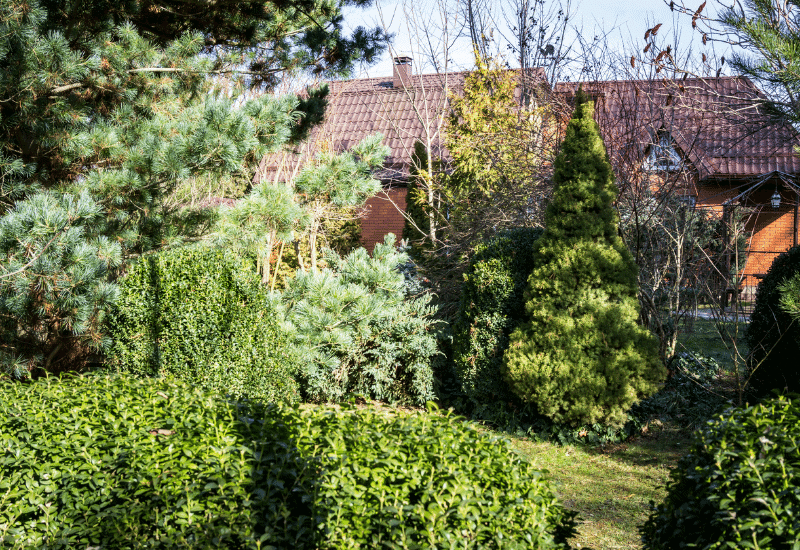
I kept pines and hardening for last. Pines are excellent for foundation gardening and small varieties also for other uses, from hedges to borders and even as ground cover!
Pines have a lot of advantages when it comes to gardening. In fact, you will hardly find any grand garden without one. Let’s see them:
With all the different species of pines you can grow in your garden, you can use them even as ground cover, grow dwarf varieties in pots, or make that green backdrop to your garden and cut out of sight that ugly block of flats… But the problem is, how can you tell the different varieties apart? I’m going to tell you right now…
Simple Keys For Identifying Different Pine Tree Species
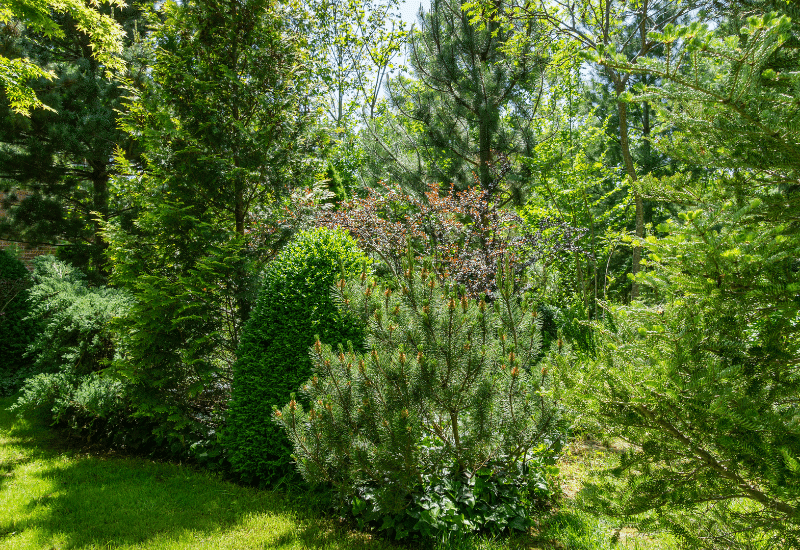
Let’s recap: to identify a pine tree correctly you need to look at differences in size and habit, cone shape and color, the length, shape and even color of the needles and finally even the bark.
Starting with the last indicator, I need to make a note: most pines have a a dark, deep, cracked and comparatively soft bark. But there are a few exceptions. Whitebark pine (Pinus albicaulis) has a light gray brown bark which is rough but it does not crack like most pines do.
But now, without further ado, let’s learn how to identify all the different varieties of pines.
Size, Shape and Habit
The overall appearance of the pine is the first thing you will notice, so its size, shape and habit. By size, we always mean adult size.
And this does not even mean the very maximum size, but the average size that the species can reach. The height is of course from the soil to the top and the spread is from side to side at the largest point.
Do remember that some specimens can grow past this size; there are plants that live exceptionally long and they become very big indeed!
By shape we pf course mean the overall shape of the tree, in particular of the branches and canopy.
Most pines have that conical shape we all know , also called pyramidal. But as we said, some have a round shape, some have a long trunk and clearly divided branches, that form distinct layers of foliage. Yet others form “clouds” of needles as the branches are bare near the trunk…
Yet again, the branches can grow up, out or down from the trunk. Some branches are almost straight, others twist.
So you see that there is a large variety of shape in pines within the overall model.
By “habit” gardeners mean “the way a plant grows naturally”. Some tend grow upright, others tend to bend, or spread out etc. What is more, the branches can be thick or sparse…
So, when you look at your pine tree from a distance, these are the elements you want to note down, size, shape and habit.
But how about when you get up close to the tree? Let me tell you…
Identify A Pine Tree By Needle
Pines don’t have actual flat leaves but needles, like firs. But unlike firs, pine needles grow in little groups, or technically “fascicles”, while fir needles grow individually on the branch. Botanists use the number of needles in each fascicle to identify pine species.
Some pines have fascicles of 2, others, 3 and others 5 needles in each fascicle, and rarely 8.
The length of the needles can vary a lot; the longest can be 18 inches (which is a whopping 45 cm), and you will find them on the branches of the aptly named longleaf pine (Pinus palustris) while the smallest are only one inch long (2.5 cm) and they grow on the American species foxtail pine, Pinus balfouriana.
The color of the needles may change too, from green to blue. Some cultivars have been beed to bring out the blue color in the needles, like Pinus flexibilis ‘Extra Blue’. However, blue leaves are more typical of spruce, another conifer, and not pine trees.
There are also some pines with golden needles, like the small Pinus mugo ‘Schweizer tourist’.
Other details you may look at are how hard or soft the needles are, but this is maybe just a detail in most cases.
Cone Shape and Color in Pines
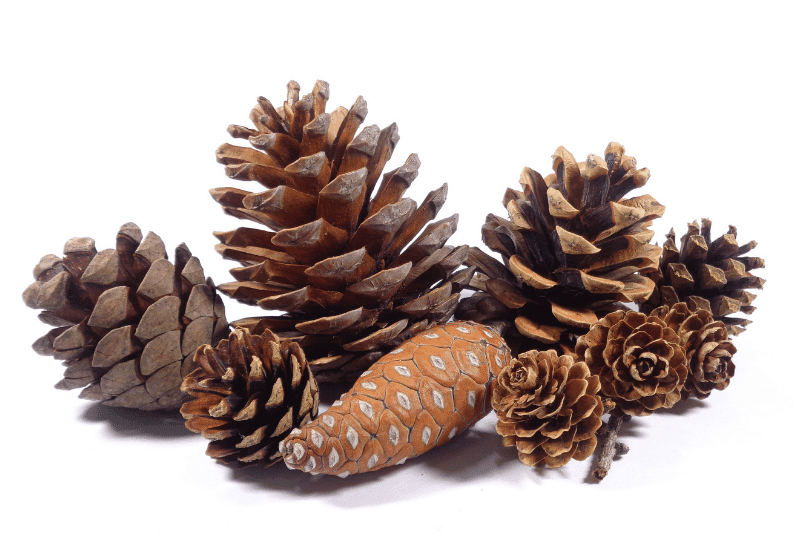
Pine cones are like little works of art, and there are many shapes, sizes and even colors. Some are woody and hard, some are thick and compact, others less. Some are straight others bend. Some are rounded at the tip and others are more pointed.
And then of course there is the size… Pinus banksiana has tiny cones: they are between 1.5 and 2.5 inches long (4 to 6.5 cm). On the other hand, Pinus tectote has cones that can easily pass the foot in length (30 cm) and even reach 20 inches, or 50 cm!
Most pine cones are brown when mature, but then there are yellow, red shades and even gray shades in them…
Pine Bark
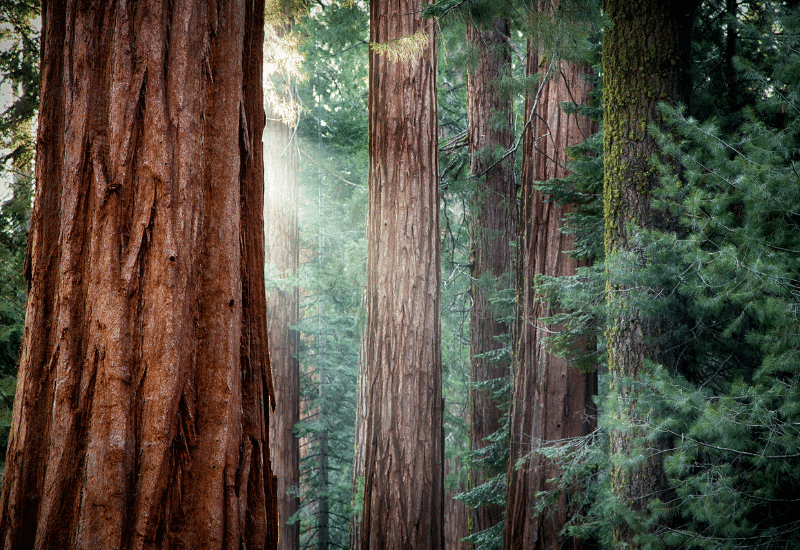
As we said, most pines have dark brown, thick and cracked bark. It is quite soft under the first outer layer. This is the “classic” or “iconic” pine bark we all recognize. But there are changes in color, from dark brown through red to gray and even yellow…
Then there is flaky bark on some pines, like lacebark pine (Pinus bungrana) which literally exfoliates as it matures.
And “white pines” can have smooth bark on their trunks. This very often happens especially when they are young, but then it becomes rough and partly cracked. We call white pines those species with a light gray bark.
It takes a bit of knowledge and attention to detail to identify a pine correctly. But it also takes a bit of practice – and that’s why we are going to look at some iconic pine species and varieties in detail next.
This way you can get the hang of how you identify pines and at the same time you may well meet the variety you have been looking for to grow in your garden!
15 Types of Pine Trees That Are Perfect For Your Yard
Let’s be honest; we can’t go through all the 126 natural species of pines plus the cultivars and identify each one… That would take a book! But we can choose some species and do this together.
Mumble, mumble, I came up with a list of “signal pine species”; I have chose some that are as diverse as possible but also have classic traits of a group of pines. So some are large, some are small, some are conical and some are not…
This will help you in two ways: you will see with clear examples how you can identify trees.
Here are 15 of our favorite types of pine trees to provide year-round color and texture to your home landscape.
1. Scots Pine (Pinus sylvestris)
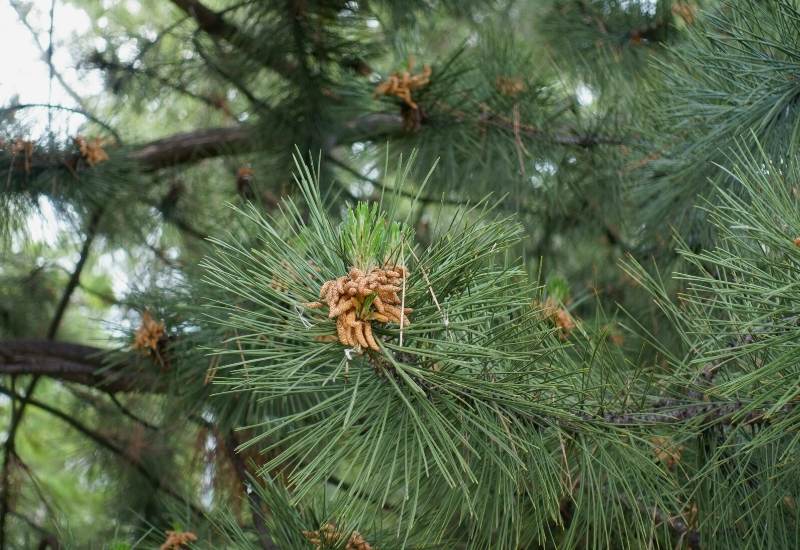
Scots pine is a classic of the conifer genus; it’s “the” Christmas tree we all recognize. It has the iconic conical shape, red and cracked bark, and the fascicles have 2 needles.
These are green and between 1 and 2 inches long (2.5 to 5 cm). The cones are red when they are fertile and then turn brown when they are mature. They take two years to mature. It has a very straight and upright trunk.
It is widely grown as to be cut and decorated during the festive season, but it also has another advantage for your garden: it grows very fast, so you can use it for that “quick fix” on a large scale.
2. Sugar Pine (Pinus Lambertiana)
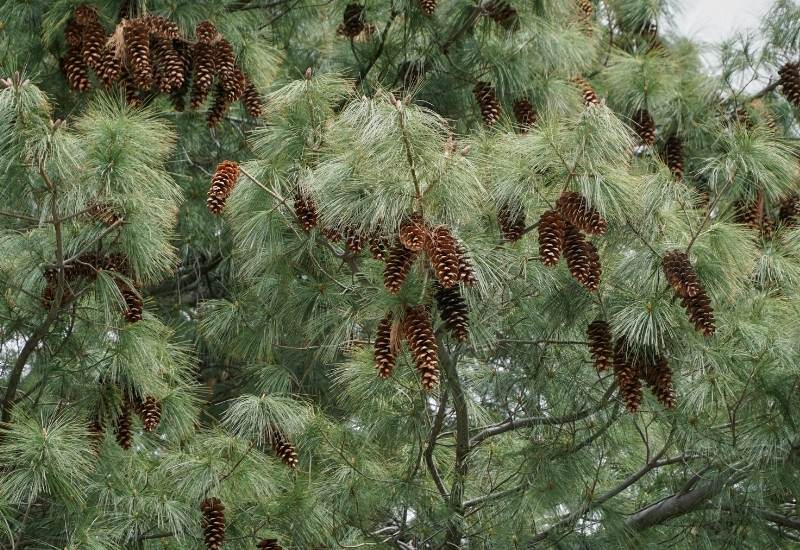
It should be easy to identify sugar pine, a.k.a. giant pine! It’s a colossus of the genus, and not just in height… The pine cones are massive! They can grow to almost 22 inches in length (56 cm)! However, on average they are 12 inches long (30 cm).
They start off green and they turn light russet brown when they are mature. The fascicles have five needles each, and they are about 3 inches long (7.5 cm). The trunk is upright and the shape is conical.
This is not an easy pine to grow if that is your intention. It is far top big for an average garden and it is not cold hardy, but if you are the keeper of a massive manor or park, please go ahead!
3. Monterey Pine (Pinus radiata)
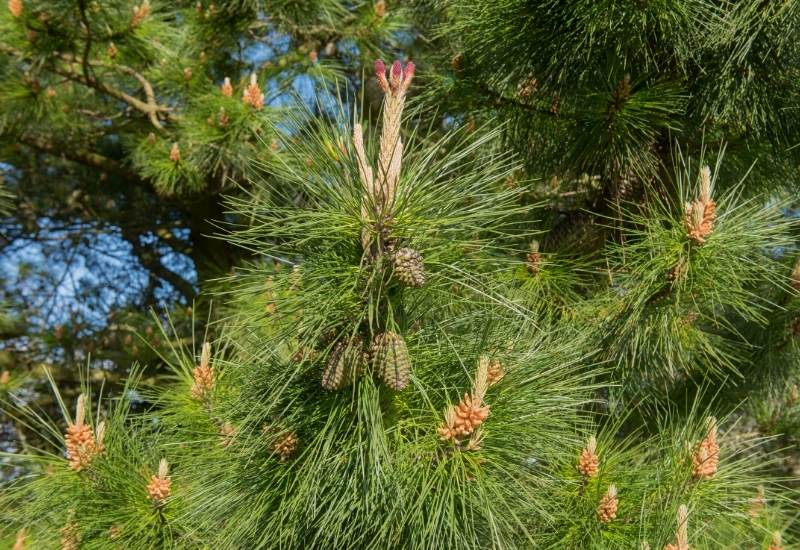
Monterey pine is very decorative and distinctive in appearance. The trunk is large and it is not straight; it twists and bends. The bark is cracked with a ribbed appearance and black; this should make identification easy.
The needles are green and in fascicles of two and three. The crown is umbrella shaped and finally the cones are wide and pointed, green when young, brown lat on and finally almost black.
It is grown for its timber but also for its original bark, which you can use as mulch. It is not very cold hardy, but it is a wonderful landscape tree thanks to its habit and shape as well as to the contrast between the emerald leaves and black bark.
4. Mugo Pine (Pinus mugo)
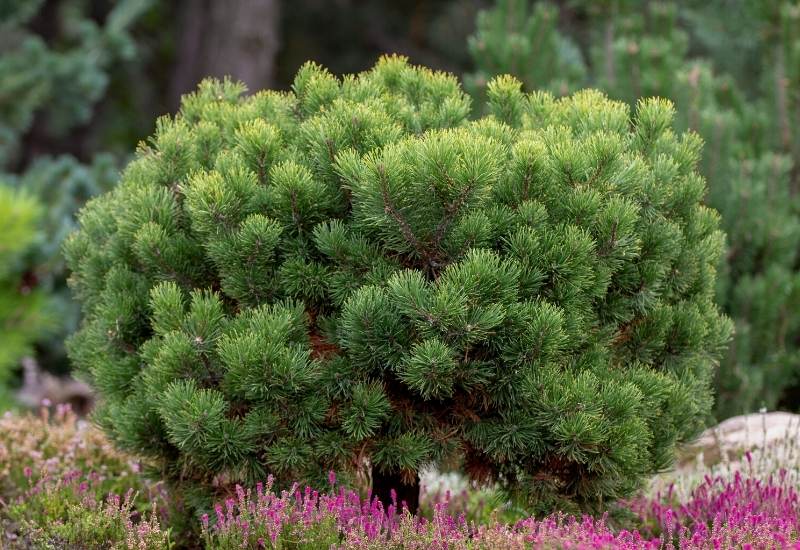
Mugo pine is a dwarf pine verity which is very common in gardening. In fact there are many cultivars, some with colored foliage. It’s actually a large species, and some are shrubs, others small trees.
They rend to form round shapes, with height and spread matching. The needles come in fascicles of 2. The bark is brown gray with shallow cracks. The cones are slightly pointed and small, ovoid and with few scales.
Mugo pine is a gardening giant, despite its small size, or maybe because of it! You can use it as a shrub, for hedges, borders and even as ground cover and you will find loads of varieties on the market. Ah, yes, it’s also used for bonsai making…
5. Mexican Weeping Pine (Pinus patula)
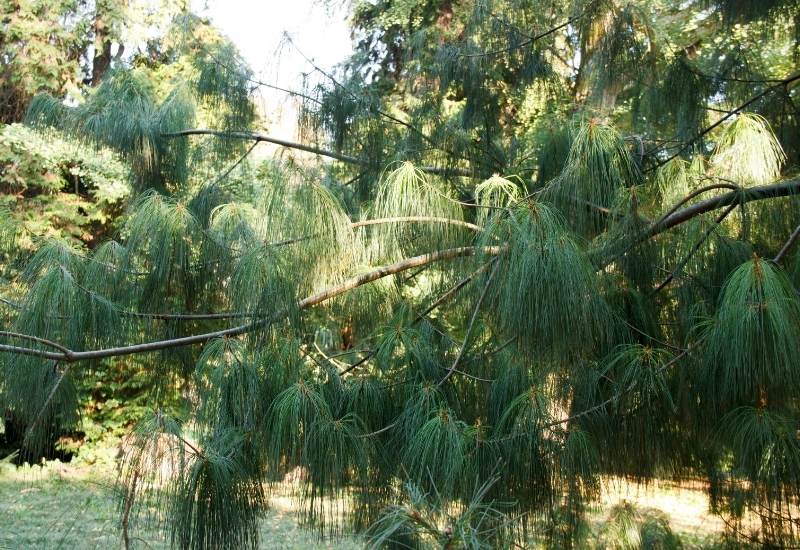
Mexican weeping pine has a unique look, so it’s easy to identify. The name says it all: it has long thin and slightly arching branches and long drooping needles that come in groups. These can reach 6 to 10 inches long (10 to 25 cm) and they have a soft look.
The fascicles are very irregular: some have 3, some 4 and a few even 5 needles. The cones are large and tubular, with many scales. The bark is cracked a d gray to red. The trunk is upright and the tree is of a “soft conical” shape.
Mexican weeping pine is becoming very popular with gardeners all over the world. It is an excellent landscape tree which adapts well to urban and formal settings as well as to large public parks.
6. Italian Stone Pine (Pinus pinea)
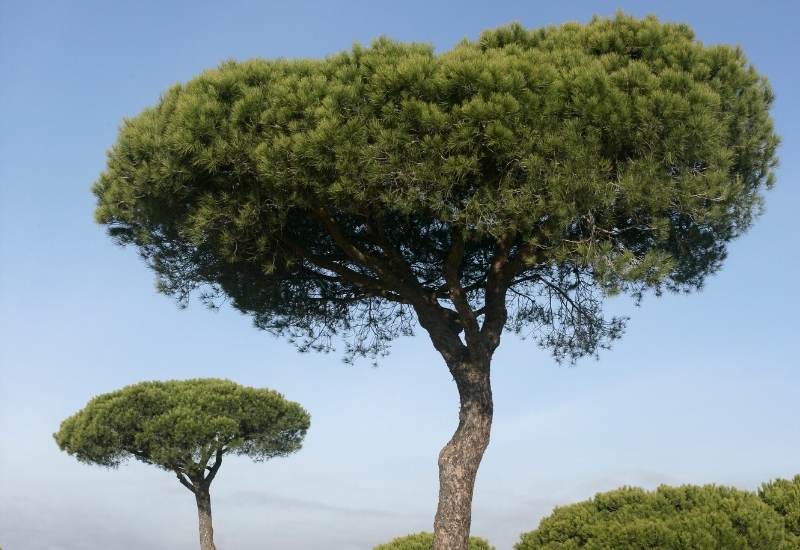
I must admit Italian stone pine is one of my favorites, and it’s easy to identify. It’s the classical pine you see in pictures of Rome; that city is filled with these trees. It has long barren and straight to slightly bending trunks.
At the very top, it branches out sideways and it forms an almost flat crown with a shallow umbrella shape.
It looks like a flat cap mushroom on a giant scale… Its fascicles have 2 needles, 4 to 7.2 inches long (10 to 18 cm). The bark is deeply cracked and brown. Finally, it has wide and full cones and its seeds are delicious!
Italian stone pine is hard to grow away from its native Mediterranean basin, but it is an impressive tree; for its shape and its “Roman Empire connotation” it is a fabulous garden plant. Of course, it is widely grown to harvest its seeds, a.k.a. pine nuts.
7. Lacebark Pine (Pinus bungeana)
Lacebark pine is so easy to identify: it has exfoliating bark. It comes off ten straight trunks in a beautiful patchwork of colors, white, silver gray, cream yellow and russet! If this is not enough to recognize it, the habit is upright but oval, and the trunk branches off lower down.
The cones are small with only one to two dozen scales. The fascicles have 2 to 3 needles, each between 2 and 4 inches long (5 to 10 cm).
The bark of this conifer is a real spectacle! For this reason, it is an excellent plant for gardens; grow it as a specimen plant or in small groups. It would also look good in formal and urban gardens thanks to its marble like bark.
8. Longleaf Pine (Pinus palustris)
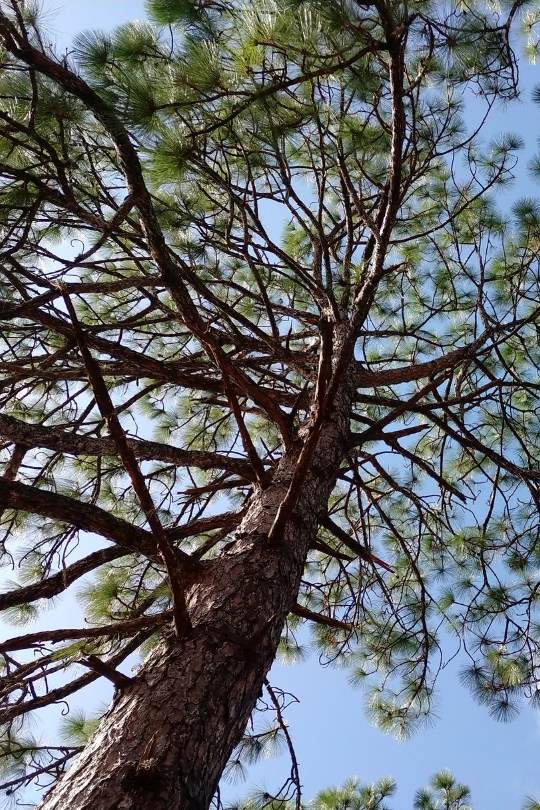
Of course you will recognize long needles in longleaf pine! They are between 8 and 18 inches long (20 to 50 cm), so, look closely an you won’t be mistaken.
The problem is that you may have to look down on the ground for the needles, because it has a long and upright trunk which is mainly used for lumber.
The fascicles have 3 leaves each. The bark is brown and deeply cracked. Finally, the cones are wide and fairly large.
Longleaf pine is mainly grown for lumber, given its straight and long trunk. If you have a large garden and you want a fast growing giant though, it could be an option.
9. Maritime Pine (Pinus pinaster)
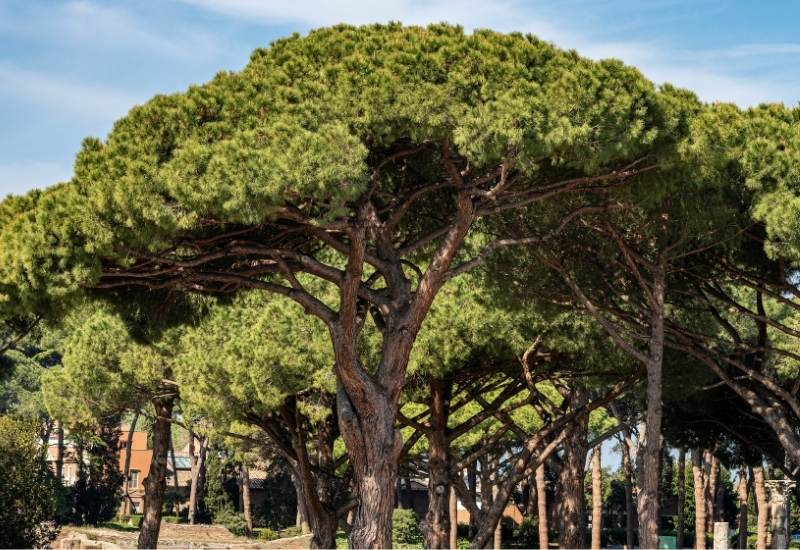
Maritime pine is another Mediterranean looking species, so you may confuse it with Italian stone pine. It has a similar crown, umbrella shaped but thicker than its relative.
But the main distinction is that Italian stone pine has tall upright trunks while maritime pine has bending branches that start off very low down the trunk.
The needles are green and in fascicles of two or three. The bark is cracked, brown gray on the outside and brown red on the inside. The cones are long, conical and often bent at the tips.
It’s a great specimen tree; it is very sculptural and it adapts well to very dry and sandy soil. It is ideal for Mediterranean and xeric gardens.
10. Bull Pine (Pinus ponderosa)
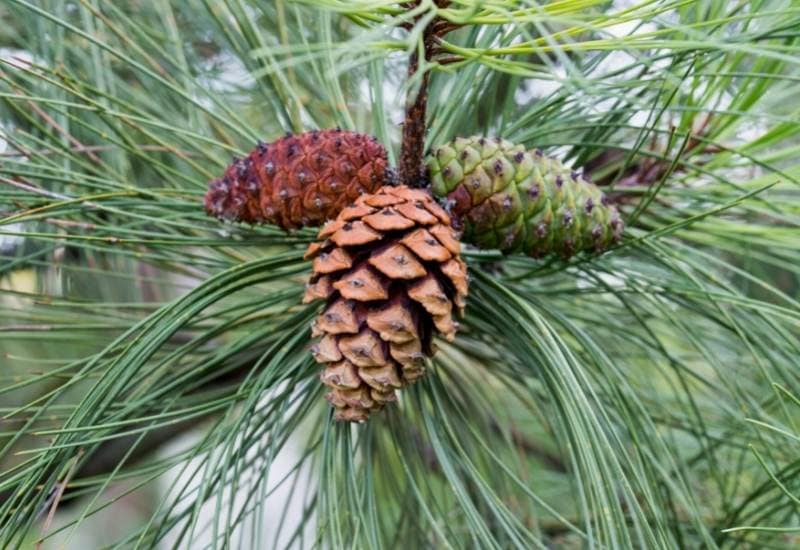
Guess how you can identify bull pine? Even the Latin name means “impressive” and “powerful” and it’s a colossus! The overall shape is upright and conical to cylindrical with a pointed tip. In isolation, the branches start off from the main stem fairly low down.
The bark is brown red and cracked. The cones are medium size (about 10 inches or 25 cm long). They are fairly wide and conical, brown in color. The needles are green, 4 to 7 inches long (10 to 18 cm) and in fascicles of 2 or 3.
Ok, you guessed that you can’t grow bull pine unless you have quite a big garden… It’s mainly a forest tree.
11. Red Pine (Pinus resinosa)
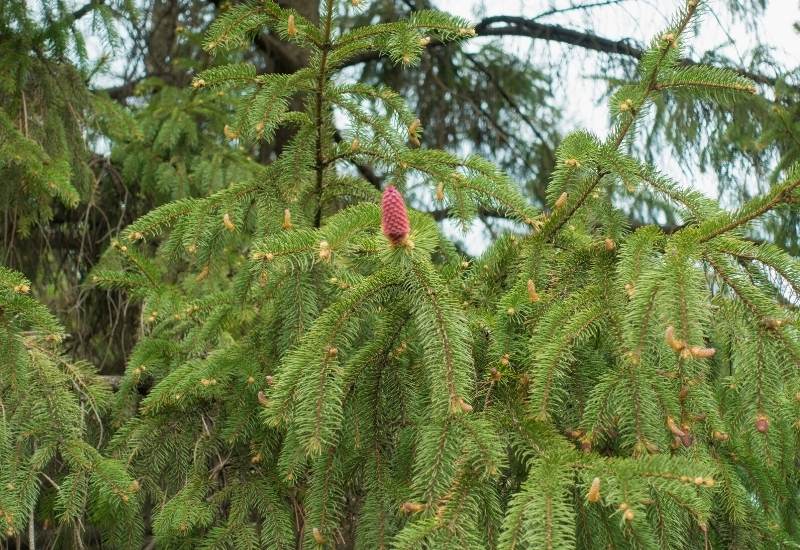
Classical looking red pine is also called Canadian pine or Norway pine. But the scientific name gives away one thing you can use to identify it: it’s resinous. It has an upright habit with a conical shape when young. But when it ages, it becomes rounded.
The bark is cracked and brown and it peels off easily. The needles are straight to slightly twisted, 4 to 7 inches in length (10 to 18 cm) and in fascicles of 2. The cones are rounded and small, with few scales, up to about 2 dozen.
It’s an excellent specimen tree; it has the very classical “northern pine” look, but keep in mind that it will change shape over the years. On the other hand it is very cold hardy.
12. Japanese Red Pine (Pinus densiflora)
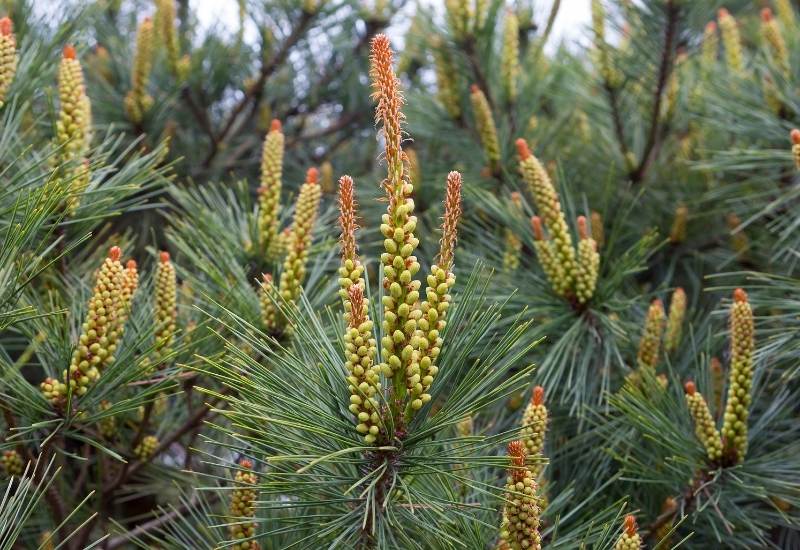
Japanese red pine is mainly identified by the thickness of the canopy. In fact it is very unique as a pine because the foliage is super thick. The shape of the crown is round or oval and it’s a small tree.
The bark is flaky and usually red, but sometimes gray. It branches quite lower down the trunk, aiding the low and thick shape.
It has a very oriental look overall. The needles of a Japanese red pine come in fascicles of 2 and they tend to point upward. They can be 3 to 5 inches long (7.5 to 12 cm). The cones start off as blue green and then they turn brown. They only have one or two dozen scales.
As a ornamental plant, Japanese red pine is fantastic. Its shape, color and habit make it a very ornamental and elegant tree. It’s ideal for foundation or specimen planting. Because it is small, you can grow it even in modest gardens. For the oriental look, it’s perfect! It’s also a wonder as a bonsai!
13. Turkish Pine (Pinus brutia)
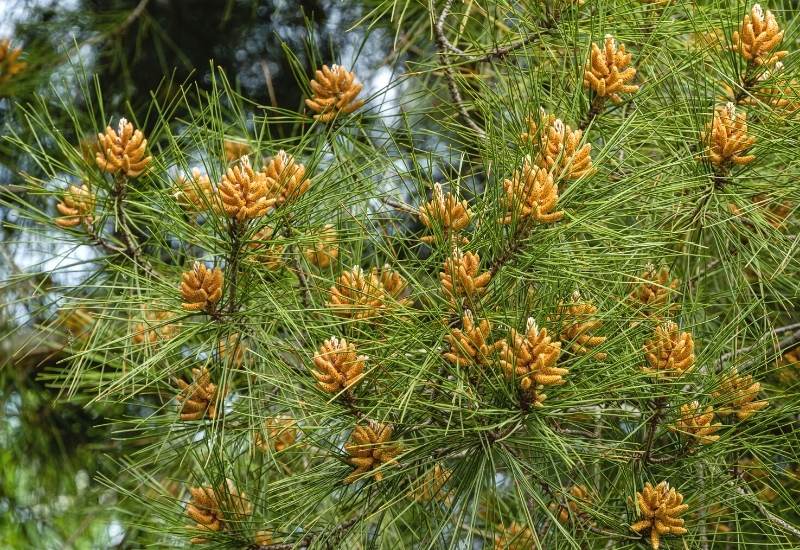
Turkish pine is beautiful but it’s hard to identify because it’s a “shape shifter”… It can have flat, umbrella like crowns, but also round ones or pointed ones… The branches point outward forming clouds of foliage. The trunk may split fairly low down… But let me help you…
The cones are small, conical and red brown with white spots at the tip of each scale (called the “prickle”). You see, even with this pine we found a way to tell it from the others. The bark is red gray and cracked. The needles come in fascicles of 2.
Turkish pine is a wonderful tree for hot gardens. It loos striking as a specimen tree or in foundation planting. Be ready to have a few surprises in terms of shale though…
14. Two Needle Pinyon Pine (Pinus edulis)
Two needle pinyon pine is distinctive as a small to medium elegant conifer. When it’s small, it can be mistaken for a shrub. The trunk is usually bent, with low branches that grow out and up from the center. However, sometimes they arch.
The overall shape is conical to ovate, usually with a pointed tip. The cones are small and almost spherical, brown to orange brown in color and with very few scales, rarely more than 15. However the seeds are edible.
The bark is gray and cracked. But maybe the main way to recognize it is by the needles. They are usually 2 per fascicles but some times 1 or 3 and they are connivent. This means that they grow together, almost attached to each other.
This is a fairly small variety you can easily grow in most gardens. It’s quite decorative and it gives you the wild mountain look, if that’s what you are after for your little corner of paradise.
Growing tips and other identification notes:
15. Limber Pine (Pinus flexilis)
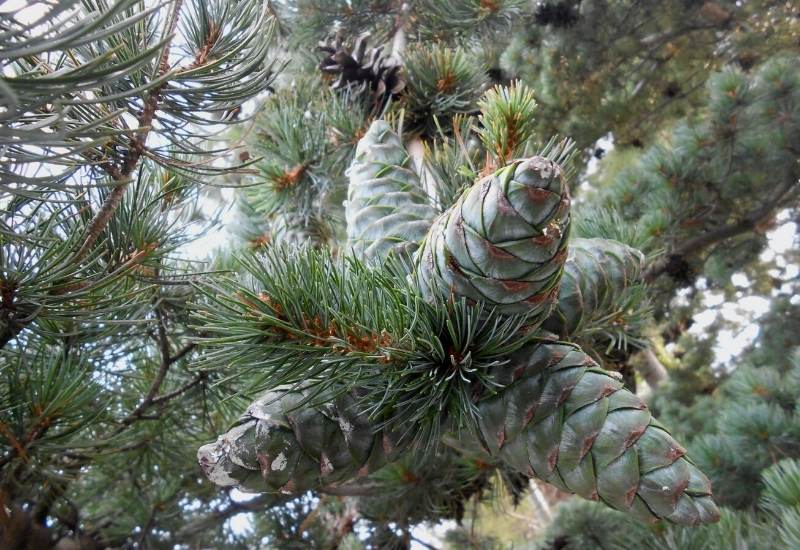
Limber pine is not a famous variety but it has distinctive traits you can use to identify it. It has a conical and pointed shape, with an upright trunk, which can become quite thick with age. The branches point slightly upward.
The bark is gray and it’s smooth when it’s young but it progressively becomes more and more cracked as the tree ages. The needles are soft looking and green to blue in shade. They are short, between 1 and 3 inches long (2.5 to 7.5 cm).
The fascicles have five needles each. Finally, the cones are conical but green to blue when young, and with few scales, about 2 to 3 dozens. They also tend to appear in clusters on the branches, and these are the main signs to look out for to identify it.
It’s a good landscape plant, excellent for foundation planting. It is quite cold hardy and it is very useful to gardeners because it can adapt to harsh conditions, including harsh soil.
Pine Identification: Much More Fun than You Thought!
Once you know what to look out for, identifying pine trees can be a lot of fun, do you agree? I think so anyway.
We have only had time to study a few pine varieties together, and maybe you have found the one you need…
Or maybe you have just got an idea of what type of pine you want… There are big and small ones, straight and bending ones, conical, round and even flat crowned pine trees…
But if you have had as much fun as I have had writing this article, now you can recognize 15 canonical pine species, there are still 111 to go!

Written By
Amber Noyes
Amber Noyes was born and raised in a suburban California town, San Mateo. She holds a master’s degree in horticulture from the University of California as well as a BS in Biology from the University of San Francisco. With experience working on an organic farm, water conservation research, farmers’ markets, and plant nursery, she understands what makes plants thrive and how we can better understand the connection between microclimate and plant health. When she’s not on the land, Amber loves informing people of new ideas/things related to gardening, especially organic gardening, houseplants, and growing plants in a small space.

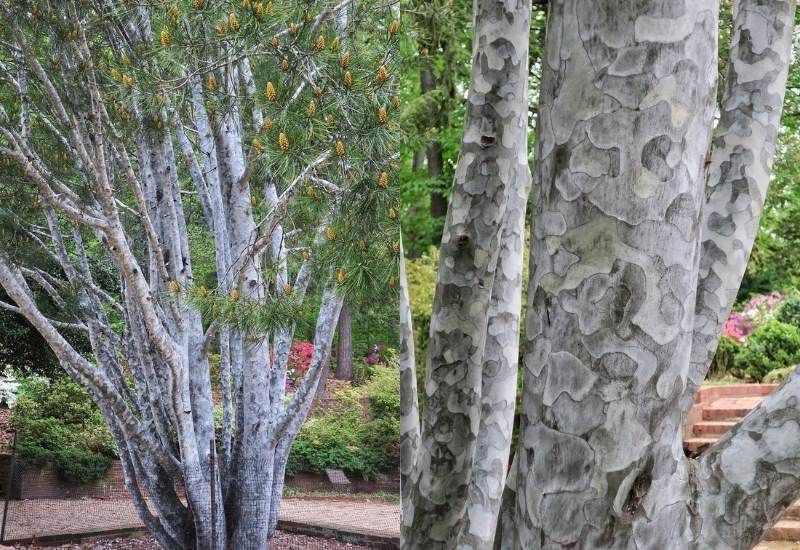
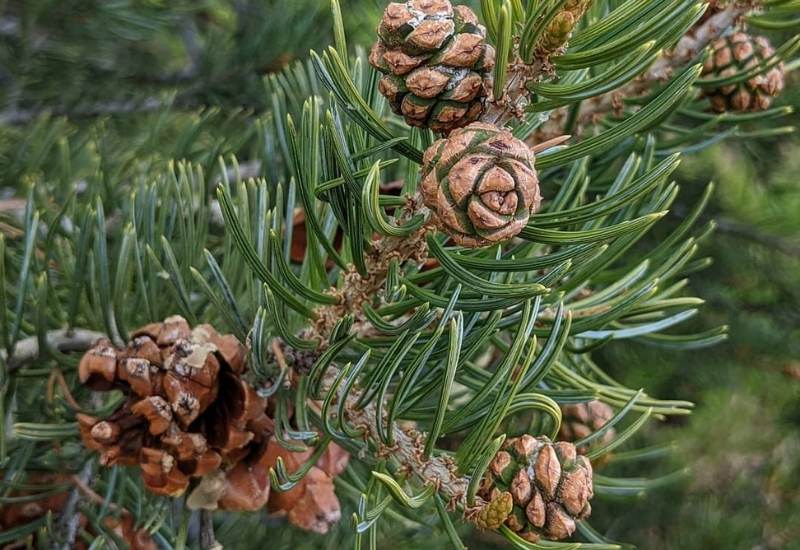
Hello
I sadly lost a very large pine to an early and heavy snow. Could you please help me identify what type of pine it is. It had many trunks that spread out wide from the base (great for climbing) small roundish cones. I have pictures if you have time to help. Thank you!